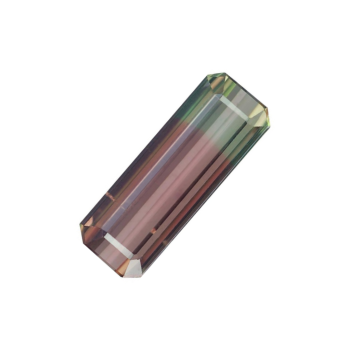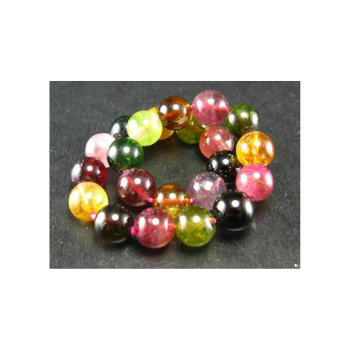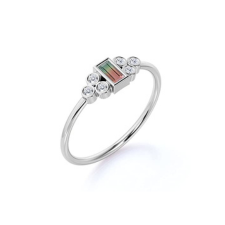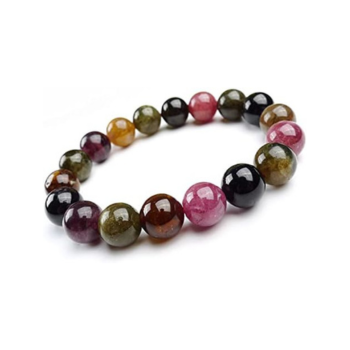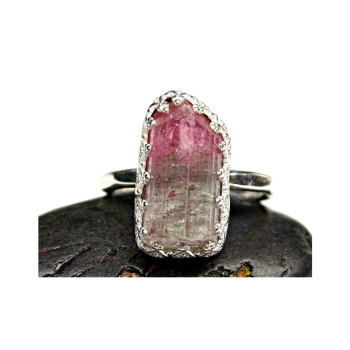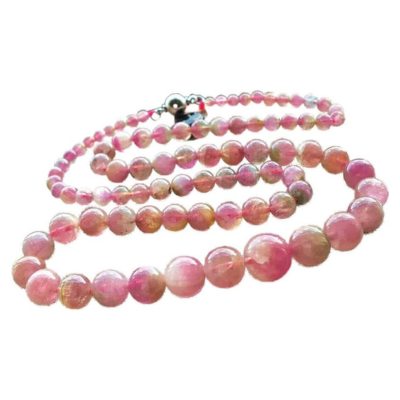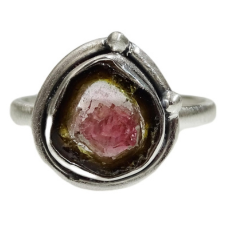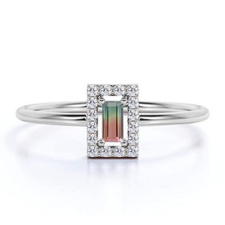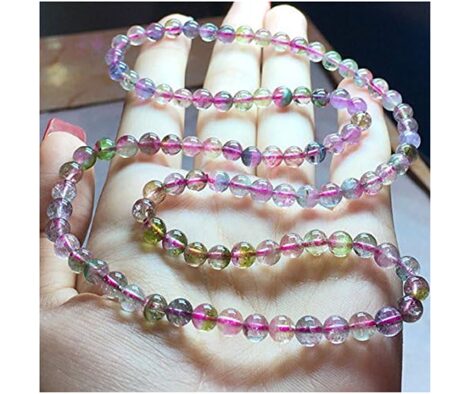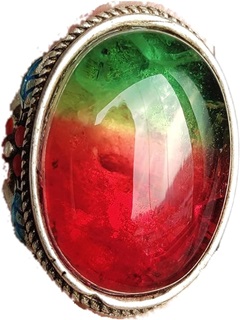What is a watermelon tourmaline?
The watermelon tourmaline is an exceptional strain of the gemstone tourmaline. It flaunts three distinctive colors in a single crystal. The green is akin to the skin of a watermelon. The pink is similar to the sweet flesh of the fruit. And finally, the white is comparable to the rind of the aqueous summer fruit. Amazingly, the unusual color combination is one hundred percent natural.
6.03ct Awesome AA Unheated Octagon Bi Color Watermelon Tourmaline
Click On The Image
Tourmaline Family Of Minerals:
Tourmaline is the name given to a whole family of related gemstones. These gemstones have a complex and changing composition since they are mixed crystals of boron, silicon & aluminum. The aluminium-boron-silicate crystals also contain other elements such as sodium, lithium, calcium, magnesium, manganese, iron, chromium, vanadium, fluorine, and sometimes copper. The changing configuration imparts a motley of colors to the gemstone. Furthermore, depending on the viewing angle, these colors change and look more or less intense.
The term tourmaline originates from the Singhalese language phrase’ tura mali.’ It means ‘a stone blended with vibrant colors.’ The prefix watermelon alludes to the succulent colors mimicking the summer fruit’s skin, flesh, and rind. The influential mineral collector George Robley Howe of Norway, Maine named the watermelon tourmaline strain.
| What Makes Watermelon Tourmaline Stand Out Among Gemstones? •The Unique “Watermelon” Hue: Pink Center And Green Rind. •Formation Process Contributing To Its Distinctive Color Zones. •How Watermelon Tourmaline Compares To Other Varieties Of Tourmaline? |
|
| Understanding The Physical And Chemical Properties Of Watermelon Tourmaline: •Examining The Gem’s Physical Properties: Hardness, Transparency, And Luster. •The Role Of Manganese And Lithium In Its Coloration. |
|
| The Geographical Sources Of The Finest Watermelon Tourmalines Ever Found. •Exploring The Mines Of Minas Gerais For Premium Specimens. •Discovering Watermelon Tourmaline Gems In Madagascar. •Global Distribution: Where Else Is Watermelon Tourmaline Found? |
|
| Navigating The Market: Tips For Buying Watermelon Tourmaline. •Understanding Pricing: Factors That Influence The Cost Of Watermelon Tourmaline. •Identifying Genuine Watermelon Tourmaline In A Crowded Gem Market. •Recommended Settings And Cuts To Best Showcase The Gemstone’s Unique Color. |
|
| The Metaphysical Properties And Uses Of Watermelon Tourmaline In Jewelry. •Exploring The Gemstone’s Purported Healing Benefits And Energy. •Watermelon Tourmaline In Jewelry Design: Trends And Traditions. •How To Care For And Maintain Watermelon Tourmaline Jewelry. |
What Makes Watermelon Tourmaline Stand Out Among Gemstones?
The gemstone captivates with its unique color combination, mirroring the summer fruit's green skin and juicy pink flesh. This gemstone's natural tricolor appearance sets it apart in the mineral world, offering a visual feast that's both rare and mesmerizing. Its ability to blend colors seamlessly within a single crystal showcases the wonders of nature's palette, making it a favorite among collectors and designers alike.
The Unique "Watermelon" Hue: Pink Center And Green Rind:
Watermelon tourmaline captures your imagination with its vibrant hues reminiscent of a ripe watermelon. This gemstone showcases an extraordinary display of color - a striking pink or red center enveloped by a lush green rind. The allure of watermelon tourmaline lies in its unique color variation. Often, the outer layer of the gemstone may present in shades of deep green to bluish-green, while the inner core ranges from pale to vibrant pink or red, echoing the natural colors of a real watermelon.
Fascinating Crystal Structure:
The crystal structure of this gem is equally fascinating. Typically found in elongated, prismatic crystals with a hexagonal cross-section, they exhibit parallel striations that add to their allure. Their transparency, from transparent to translucent, allows light to play marvelously with their colors, creating mesmerizing visual effects. Notably, watermelon tourmaline may exhibit pleochroism, displaying different colors and intensities, further enhancing its beauty when observed from various angles.
Complex Chemical Composition:
Watermelon tourmaline belongs to the tourmaline mineral group, characterized by a complex chemical composition that contributes to its diverse coloration. Elements like sodium, calcium, lithium, magnesium, aluminum, iron, manganese, and vanadium influence the gemstone's color in varying proportions. These elements, part of the complex borosilicate structure of Tourmaline, play a crucial role in giving watermelon tourmaline its distinctive pink and green colors.
Testament To Nature's Artistry:
The formation of watermelon tourmaline is a testament to nature's artistry. These gems often originate in granitic pegmatites, forming from mineral-rich solutions within the cavities of these rocks. The specific combination of elements, along with the temperature and pressure conditions, leads to the development of tourmaline crystals with the characteristic green and pink layers. This process mirrors the crystal's growth, starting with a pink core that gradually transitions to a green rind, mirroring the elements' changing concentrations during the crystal's formation.
Unique Blend Of Natural Beauty And Geological Intrigue:
In jewelry, watermelon tourmaline's unique coloration makes it a popular choice for designers seeking to add a touch of nature-inspired beauty to their creations. Whether faceted to highlight its color depth or cut into slices to enhance its resemblance to a natural watermelon, this gemstone remains a marvel in the world of gemstones, offering a unique blend of natural beauty and geological intrigue.
Formation Process Contributing To Its Distinctive Color Zones:
The unique formation process of watermelon tourmaline creates distinctive color zones, making each piece unique. The journey of watermelon tourmaline crystals from the depths of the Earth to the surface is a fascinating tale of geology and chemistry.
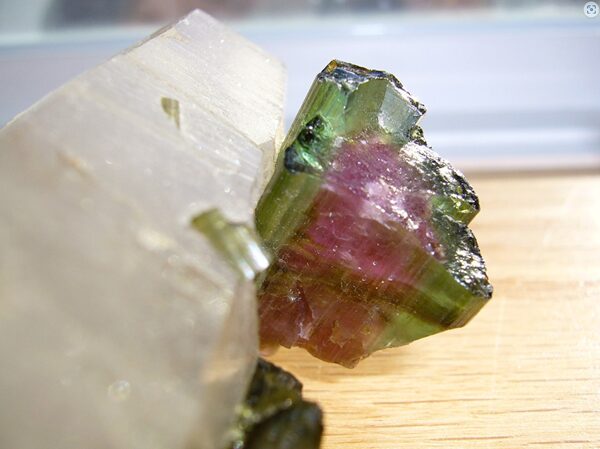
|
|
Watermelon Tourmaline In Matrix From Minas Gerais. Photo. Licensed under CC BY-SA 3.0 DEED. |
Variety Of Elbaite Created by Cooling Molten Magma:
At its core, watermelon tourmaline is a variety of Elbaite, part of the tourmaline family known for its vibrant colors. The formation of these crystals often begins in veins within rocks, created by cooling magma. As magma cools, it forms large cracks filled with mineral-rich water. Over time, these minerals crystallize into Tourmaline. The specific trace elements present, such as manganese and lithium, play a crucial role in the gem's coloration. As the crystal grows, changes in the availability of these elements can alter the color of the Tourmaline, creating distinctive green and pink layers that resemble a watermelon slice.
Complex Geological Processes:
Watermelon tourmaline's formation involves complex geological processes. Initially, it forms in granitic pegmatites, where magma cools slowly, allowing boron, lithium, and manganese to concentrate. These elements are essential for tourmaline formation. The crystals start to grow within these mineral-rich solutions, with specific conditions leading to the development of the characteristic color zones. In some cases, regional metamorphism can also play a role, altering the chemical composition of existing crystals and enhancing their unique patterns.
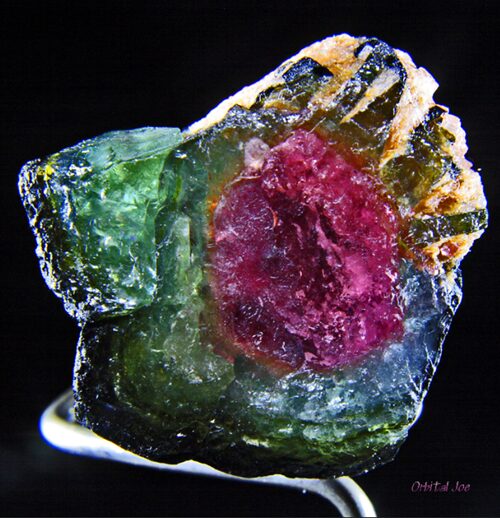
|
|
Watermelon Tourmaline Photo by Orbital Joe. Licensed under CC BY-NC-ND 2.0. |
A Symphony of Colors
This gemstone's ability to showcase up to 15 colors or shades in a single crystal has earned it the nickname "Rainbow Gem." The bi-colored and multi-colored zoning occurs when trace elements change in concentration or composition during the crystal's growth, leading to a core of one color and an outer edge of another.
Gem Watermelon Bicolor Tourmaline Bracelet From Brazil
Click On The Image
How Watermelon Tourmaline Strain Compares To Other Varieties Of Tourmaline:
Distinctive Color Zones - Watermelon Tourmaline's Unique Display:
Watermelon tourmaline etches its mark into the mineral world with its unique, vibrant display. Unlike other tourmalines, it features colored zones across the length of its crystals, presenting a distinctive rounded triangular shape that vividly recalls a slice of natural watermelon. This watermelon variety is notably distinct for its seamless blending of pink and green hues within a single crystal, setting it apart from other tourmaline species.
Chemical Composition and Color Diversity - The Spectrum of Tourmalines:
Tourmalines generally boast an impressive range of colors attributed to trace elements like iron, manganese, and titanium, which induce colors from greens and blues to reds and pinks. Some, like the rubellite and indicolite varieties, offer deep, saturated colors in red and blue hues, respectively, owing to their unique chemical compositions. Rubellite, for instance, maintains its color under different lighting conditions, making it a coveted choice for jewelry. Indicolite stands out with its deep blue color, a rarity among naturally occurring gemstones.
The Green Spectrum - Verdelite and Chrome Tourmaline:
Verdelite and chrome tourmaline highlight the spectrum's green end, with verdelite showcasing shades from light grassy to deep forest greens and chrome tourmaline dazzling with its intense green coloration due to chromium presence. These varieties underscore the diversity within the tourmaline family, each bringing a unique palette to the table.
Rare and Vivid Hues - Paraiba Tourmaline's Neon Colors:
Paraiba tourmaline, with its neon blue to green hues thanks to copper, represents another remarkable member of this family, offering a rare and visually striking option. Its rarity and vibrant colors make it one of the most prized and valuable tourmalines.
Earthy Tones - Dravite and Uvite Varieties:
Dravite and uvite, leaning towards earthy tones, introduce more subdued colorations to the tourmaline group. Dravite, or brown Tourmaline, and uvite, with its green and reddish-brown crystals, contrast the more vividly colored varieties, demonstrating tourmaline minerals' broad and versatile nature.
Each tourmaline variety, from the vivid and colorful Elbaite to the earth-toned dravite and uvite, contributes to the gemstone's broad appeal. Watermelon tourmaline, however, holds a special place with its unique color transition and resemblance to the summertime fruit, making it a fascinating and sought-after gemstone that beautifully illustrates nature's artistry.
14K Real Emerald Cut Real Watermelon Tourmaline Diamond Stacking Ring
Click On The Image
Understanding the Physical and Chemical Properties of Watermelon Tourmaline.
Examining The Gem's Physical Properties: Hardness, Transparency, And Luster:
Watermelon tourmaline, a variety that captivates with its resemblance to the fruit, is notable for its unique physical and optical characteristics. Its hardness, measured on the Mohs scale, ranges between 7 and 7.5, making it durable and suitable for jewelry. When polished, this gemstone exhibits a vitreous to sub-vitreous luster, enhancing its appeal with a beautiful, shiny, light-reflecting surface. The transparency of watermelon tourmaline can vary from transparent to translucent, allowing different degrees of light to pass through and reveal its inner beauty.
The Art and Challenge of Shaping Watermelon Tourmaline:
The coloration of watermelon tourmaline is its defining feature, showcasing an outer layer of green and an inner core of pink or reddish pink. The contrast between these colors gives it its distinctive name and appearance. Its cleavage and fracture characteristics are important When cutting and shaping this gemstone. Watermelon tourmaline exhibits no cleavage but has a conchoidal fracture, meaning it breaks with smooth, curved surfaces. This aspect is crucial for jewelers. This conchoidal fracture renders the gem susceptible to cracking during the cutting process. Cutters frequently face this challenge with tourmaline gemstones.
The Complex Chemistry of Watermelon Tourmaline:
Watermelon tourmaline belongs to the tourmaline mineral group and has a complex chemical composition contributing to its unique coloration. The general formula for this gemstone includes elements such as sodium (Na), calcium (Ca), lithium (Li), magnesium (Mg), aluminum (Al), iron (Fe), manganese (Mn), vanadium (V), boron (B), and silicon (Si), along with hydroxide ions (OH). These elements can substitute for each other in varying proportions within the crystal structure, leading to the gemstone's diverse color palette.
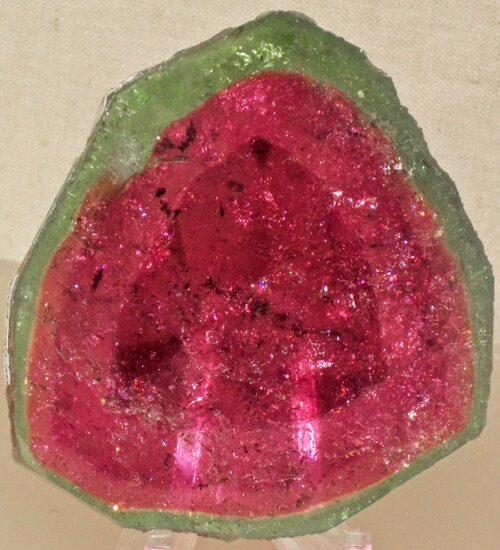
|
|
Elbaite Tourmaline From Maine Usa. Cut Slice. Photo by James St. John. Licensed under CC BY 2.0. |
Capturing Light's Dance:
The optical properties of watermelon tourmaline, such as its refractive index and pleochroism, play a significant role in its visual appeal. The gemstone's ability to display different colors when viewed from different angles (pleochroism) results from its anisotropic nature (Anisotropic means having different physical properties when tested in different directions). This characteristic, combined with the unique distribution of trace elements within the crystal, contributes to the watermelon tourmaline's distinctive color zones across the length of the crystal.
Natural Colorful Tourmaline Gemstone Round Beads Bracelet
Click On The Image
The Role Of Manganese And Lithium In Its Coloration:
Interplay Behind the Colors:
Watermelon tourmaline's enchanting coloration is primarily due to its complex chemical composition. Minerals such as manganese and lithium play pivotal roles in creating this gemstone's unique palette. The presence of manganese is responsible for the pink to red hues. On the other hand, lithium contributes to the pink inner core and the green outer layer. This distinct coloration results from varying concentrations of these elements within the crystal structure.
Natural Crystallization:
The formation process of watermelon tourmaline in nature further illustrates the significance of these elements. As the gemstone forms within volcanic rocks, a solution rich in various minerals, including manganese and lithium, seeps into cracks. Over time, these minerals crystallize, forming Tourmaline. The sequential depletion of one element from the solution and the subsequent use of others lead to the development of different colored layers within the same crystal. This fascinating process highlights the role of manganese and lithium in coloring and underscores the dynamic nature of tourmaline formation.
Magnetic Susceptibility and Color Intensity
Research indicates that the total concentration of manganese can influence the magnetic properties of Tourmaline, affecting its color intensity. Pink Tourmaline, for example, is associated with a higher concentration of manganese than less magnetic red Tourmaline. This relationship between manganese content and color depth is an area of ongoing study, offering insights into the intricate balance of elements that define watermelon tourmaline's appearance.
Implications for Gemstone Quality
The intricate interplay of manganese and lithium defines the aesthetic appeal of watermelon tourmaline and influences its valuation in the gemstone market. The "true" watermelon tourmaline, with a green exterior fading into a hot pink core, is among the most sought-after and valuable. The gemstone's pricing reflects this demand. The color intensity, clarity, and natural inclusions are marks of authenticity and boost demand.
Watermelon tourmaline's allure lies in its beauty and the complex chemical and geological processes that give rise to its distinctive colors. The roles of manganese and lithium in its formation underline the fascinating relationship between mineral composition and gemstone coloration.
Watermelon Tourmaline Ring Silver
Click On The Image
The Geographical Sources of the Finest Watermelon Tourmalines Ever Found.
Exploring The Mines Of Minas Gerais For Premium Specimens:
In Brazil, the Minas Gerais area is a treasure spot for watermelon tourmaline. The Cruzeiro mine, not far from a city called Governador Valadares, is famous for finding lots of these gems. Every year, they find many tourmalines in different colors. They pay special attention to the ones that look like watermelons - green on the outside and pink inside.
The miners look carefully at the rocks to find these gems. If they see green Tourmaline, it might mean they'll also find pink ones, which are perfect for making watermelon tourmaline.
Minas Gerais is known for more than just Tourmaline. It's also where many emeralds, aquamarines, and other precious stones come from. A long time ago, significant changes inside the Earth in this region made this place just right for these gems to form.
Discovering Watermelon Tourmaline Gems In Madagascar:
Madagascar shines with watermelon tourmaline. This gem, showing off green and pink layers, is a hit worldwide. Its pegmatite mines offer a treasure trove of tourmalines, drawing collectors and jewelers alike.
Tourmaline Hunting Adventures
Reaching Madagascar's tourmaline mines takes a lot of work. A three-hour drive from the village, through harsh terrain, leads to these hidden gems. Miners and visitors brave this path, seeking the Earth's buried treasures.
Mining Under Harsh Conditions
Mining here is backbreaking. Miners use simple tools to dig 35 meters down, searching for tourmalines. Despite the hard work and risk, the global demand, especially from China, keeps them going.
Global distribution: Where else is watermelon tourmaline found?
Apart from Brazil and Madagascar, significant sources include the United States. Here, California and Maine are notable for their tourmaline deposits. Additionally, miners have discovered this gemstone in countries like Afghanistan, Nigeria, and Mozambique. Each region offers watermelon tourmaline with variations in color and quality due to differing geological settings.
Natural Watermelon Tourmaline Pink Red Women Clear Round Beads Necklace
Click On The Image
Navigating the Market: Tips for Buying Watermelon Tourmaline.
Understanding Pricing: Factors That Influence The Cost Of Watermelon Tourmaline:
Color's Role in Value:
The appeal of watermelon tourmaline primarily comes from its unique coloration. A premium is placed on gems showcasing a vivid pink center encased by a green outer layer. The depth and saturation of these colors significantly impact the gem's value. Notably, a distinct separation between the pink and green zones, with a possible colorless band in between, marks a desirable trait. Conversely, "reverse" watermelon tourmalines, with green centers and pink edges, add an intriguing variation to the market.
Cut and Shape Considerations:
The cut of watermelon tourmaline is pivotal in displaying its color transition effectively. Polished slices or faceted cuts like princess, cushions, and pears reveal the gem's signature hues best. The presence of a chatoyant effect or eye-catching carvings can elevate the price further, given their rarity and the skill required in crafting such pieces.
Clarity's Influence:
Watermelon tourmaline is categorized under Type III gemstones, indicating that inclusions are generally visible. However, these inclusions can authenticate the stone's natural origin. The clarity and the gem's color and cut frame make it alluring. Stones exhibiting fewer or no inclusions fetch higher prices, yet the unique nature of each inclusion can add character to the gem.
Carat Weight and Rarity:
The size of the watermelon tourmaline also plays a critical role in its valuation. Larger stones, particularly those exceeding 4 carats, are rare and, thus, command higher prices. This rarity is due to the gemstone's formation process and the subsequent availability in the market.
Treatment Effects:
Some watermelon tourmalines undergo treatments like heating or irradiation to enhance their color. The impact of such treatments on the gem's value varies, with untreated, naturally vibrant stones generally being more sought after. Awareness of potential treatments is crucial for buyers aiming to make informed decisions.
Market Trends and Availability:
The market for watermelon tourmaline is dynamic, with prices reflecting the balance of demand and supply. The depletion of mines has made high-quality specimens harder to find, driving up prices. Nonetheless, options exist for various budgets, with rough stones available at lower price points and faceted or cabochon cuts commanding higher premiums.
Watermelon Tourmaline Unique Engagement Ring
Click On The Image
Identifying Genuine Watermelon Tourmaline In A Crowded Gem Market:
Spotting the Real Deal:
When buying a watermelon tourmaline, distinguishing genuine gems from imitations is paramount. Here are the crucial indicators to ensure you're getting the real gem.
Gradual Color Transition:
Genuine watermelon tourmaline showcases a natural, smooth gradient from pink to green, mimicking the fruit named after. A sharp, well-defined line between colors often signals a fake.
Hardness Test:
With a Mohs scale rating of 7 to 7.5, genuine watermelon tourmaline resists scratches from sharp objects. If the gem scratches easily, doubt its authenticity.
Clarity and Inclusions:
Natural watermelon tourmaline typically contains inclusions or minor imperfections, indicating authenticity. Perfect clarity might indicate a synthetic or fake stone.
Presence of Striations:
Look for thin, grooved lines on the gem's surface. Their absence could hint at a counterfeit stone.
Price Check:
While watermelon tourmaline isn't the most expensive gem, meager prices can be a red flag for fakes. Authentic pieces usually start at $20 to $40.
Visual and Physical Checks:
Real Tourmaline feels cold to the touch and shows color changes under different light sources, thanks to its pleochroic nature. These traits can help confirm authenticity.
Authenticity Tests:
Simple tests like scratching the gem with a steel knife or observing color changes under light can reveal the stone's genuineness. Genuine Tourmaline will scratch a knife, remain cool to the touch, and exhibit varied colors under different angles of light.
14K Real Baguette Cut Real Watermelon Tourmaline Diamond Halo Engagement Ring
Click On The Image
Recommended Settings And Cuts To Best Showcase The Gemstone's Unique Color:
Slicing to Perfection
Watermelon tourmaline's unique color variation is best displayed when cutting the gem into slices. These slices reveal the stunning pink core surrounded by a green outer ring, mirroring the appearance of a watermelon slice. This cutting method emphasizes the natural beauty of watermelon tourmaline and preserves the integrity of its color zones, making "true" watermelon tourmaline slices highly desirable and valuable.
Creative Cuts and Settings
The versatility of watermelon tourmaline allows for various cuts and settings that highlight its unique colors. While slices are popular, faceted cuts such as princess, cushions, and pears also effectively showcase the gemstone's color contrast. For a more dramatic effect, watermelon tourmaline is sometimes cut into cabochons to enhance the cat's eye effect, fetching higher prices due to their rarity. Butterfly wing shapes are another unusual but precious cut, offering a distinctive look for watermelon tourmaline jewelry.
Protective Settings
To protect the delicate edges of watermelon tourmaline slices, setting them in a bezel of gold or silver is recommended. This setting not only secures the gemstone but also complements its natural colors. Creative designs that play up the pink and green hues perhaps using a combination of pink and green gold, can further enhance the visual appeal of watermelon tourmaline jewelry.
Choosing the Right Design
When selecting watermelon tourmaline jewelry, consider designs that allow light to pass through the gemstone, accentuating its color variation. Rings set in raised settings are particularly effective in letting light illuminate the stone from behind. Choosing a jeweler experienced in working with watermelon tourmaline is essential, as they will know how to set the gem to showcase its unique colors.
Care and Maintenance
Watermelon tourmaline, with a hardness of 7 to 7.5 on the Mohs scale, is suitable for everyday wear. However, jewelry should ideally feature protective settings to extend the gemstone's lifespan. Cleaning watermelon tourmaline is straightforward, requiring only a soft-bristled brush and lukewarm water.
1 Strands Natural Blue Pink Watermelon Tourmaline Stretch Bracelet
Click On The Image
The Metaphysical Properties and Uses of Watermelon Tourmaline in Jewelry.
Exploring The Gemstone’s Purported Healing Benefits And Energy:
A Beacon for Emotional Well-being:
People herald Watermelon Tourmaline for its ability to ease symptoms of stress and anxiety while inviting opportunities for growth and healing. With its unique pink and green hues, this stone is an ornament and a companion for those on a journey toward emotional balance and spiritual enlightenment.
Enhancing Physical Health
Beyond its emotional allure, Watermelon Tourmaline stands out for its potential to bolster physical health. It's thought to support the immune system and ease muscle tension, offering a calming presence that alleviates the discomfort associated with stress and tension. This gem's broad spectrum of healing properties makes it a valuable tool for those seeking to enhance their physical well-being.
Spiritual Growth and Connection
This gemstone reaches deep into the spiritual. It acts as a "super activator" of the heart chakra, paving the way for a deeper understanding of oneself and the universe. Its use in meditation dissolves stress and promotes happiness. For those on a spiritual path, Watermelon Tourmaline offers a bridge to deeper insights and a more profound connection with the cosmos.
A Stone for Everyone
Whether worn as jewelry close to the heart or used in meditation practices, Watermelon Tourmaline is accessible to all. It is particularly resonant with Libras, Virgos, and Geminis, offering a harmonious balance and emotional support tailored to these signs. This gemstone's universal appeal lies in its wide-ranging benefits, making it a cherished stone across various cultures and practices.
Antique Watermelon Tourmaline Ring
Click On The Image
Watermelon Tourmaline In Jewelry Design: Trends And Traditions:
Watermelon Tourmaline's unique color combination makes it a sought-after choice for designers aiming to craft outstanding pieces. The following insights delve into the current trends and time-honored traditions surrounding Watermelon Tourmaline in jewelry design.
Design Trends:
Modern jewelry designers, like Natalie Lambert, embrace Watermelon Tourmaline for its rarity and elegance. Lambert's approach involves hand-selecting each stone to ensure the highest quality, acknowledging that no two stones are identical. Her designs often feature the gem set in precious metals like 14k or 18k gold, showcasing the stone's natural beauty.
Cut and Clarity:
In jewelry-making, Watermelon Tourmaline is often cut into thin slices to highlight its color transition or into faceted shapes to enhance its sparkle. The gem's clarity, dictated by its Type III classification, often includes eye-visible inclusions. These characteristics are not only accepted but celebrated as marks of authenticity.
Cultural and Historical Significance:
Watermelon Tourmaline's appeal is not just aesthetic but also historical. Recognized as an alternate birthstone for October, it shares this distinction with Opal. This modern addition to the list of birthstones reflects a broader acceptance of Tourmaline's variety and beauty within the jewelry industry.
Global Sources:
Humans mine this gemstone in various parts of the world, with Brazil being a notable source for its high-quality specimens. Other significant sources include Madagascar and the United States, particularly Maine and California. The global distribution of Watermelon Tourmaline ensures a steady, though ever-changing, supply for the jewelry market.
Pricing and Value:
Watermelon Tourmaline's value is influenced by its color, with the classic pink center and green edge being the most prized. Its rarity, coupled with the depletion of some mines, has led to a recent surge in its value. Despite this, options exist for almost any budget, from affordable rough specimens to high-end, clear, and vibrant pieces.
Chinese Old Antique Certified Natural Icy Tourmaline Ring
Click On The Image
How To Care For And Maintain Watermelon Tourmaline Jewelry:
Gentle Handling and Storage:
With a Mohs hardness of 7 to 7.5, Watermelon Tourmaline demands careful handling to preserve its beauty. Storing your Watermelon Tourmaline jewelry separately from other pieces, preferably wrapped in a soft cloth or placed inside a padded pouch, is crucial to avoid scratches or damage. Always gently handle the jewelry, especially when putting it on or off, to prevent accidental knocks that might harm the stone.
Cleaning Techniques:
When cleaning, warm, soapy water is your best bet. Use a soft brush to scrub the stone, gently removing dirt without scratching the surface. Please steer clear of ultrasonic and steam cleaners, which can cause damage to your gem. Heat and sudden temperature changes can also be detrimental, potentially causing color alteration or fracturing.
Professional Maintenance:
For more thorough care, professional maintenance can be invaluable. Specialists possess the necessary skills and equipment to clean and polish Watermelon Tourmaline without risking damage. They can also identify and rectify issues, ensuring your jewelry remains pristine.
Proper Storage Practices:
Please maintain an appropriate environment for storage. Keep your Watermelon Tourmaline jewelry away from direct sunlight and extreme temperatures. Prolonged exposure can fade the colors or damage the gemstone. Store your pieces individually to prevent scratches and tangling. Use soft cloth pouches or compartments within a jewelry box.
See More Gemstones As Follows
